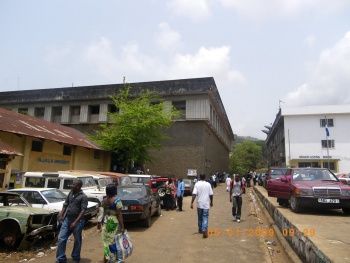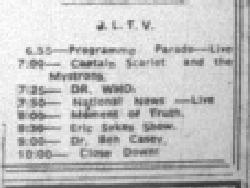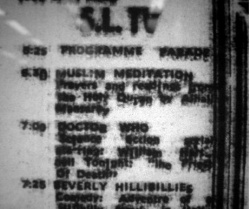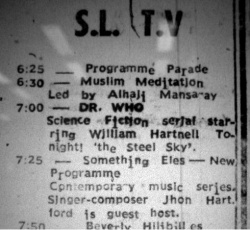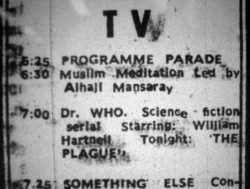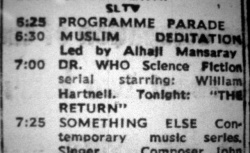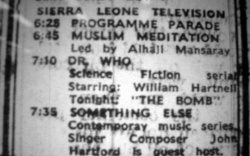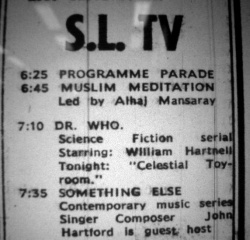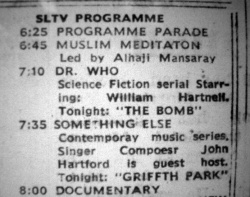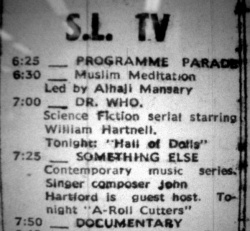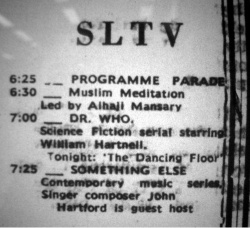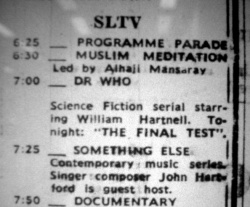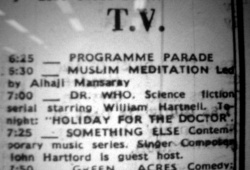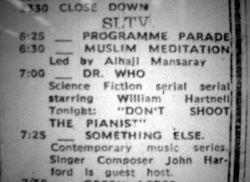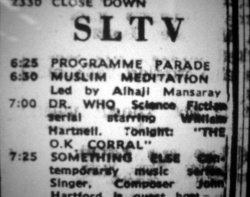Difference between revisions of "Sierra Leone"
Jon Preddle (talk | contribs) |
Jon Preddle (talk | contribs) |
||
| Line 247: | Line 247: | ||
The plot description and the comment that it was the first one with white hair have led some to wonder whether this was an out of contract repeat of the William Hartnell story, [[The Savages]]. But the story description (which was told some 26 years after the event, by someone with only a passing interest in '''Doctor Who''' and relayed via a third person, so some distortion of memory is to be expected) could equally apply to [[The Monster of Peladon]], one of the Jon Pertwee stories purchased in late 1979. | The plot description and the comment that it was the first one with white hair have led some to wonder whether this was an out of contract repeat of the William Hartnell story, [[The Savages]]. But the story description (which was told some 26 years after the event, by someone with only a passing interest in '''Doctor Who''' and relayed via a third person, so some distortion of memory is to be expected) could equally apply to [[The Monster of Peladon]], one of the Jon Pertwee stories purchased in late 1979. | ||
| − | (Breaking the description down, the "one with white hair" is Pertwee rather than Hartnell (to many, Pertwee and Baker were the only Doctors, so Pertwee would be considered by those to be "the first"; the "cavemen" are the Peladon miners; the "futuristic city" is the refinery control room; and "put in a machine and tortured" could be scenes of those being zapped by the "ghost of Aggedor", being blasted by the sonic cannon, or assaulted by the mind-scrambling automated defence system outside the refinery, | + | (Breaking the description down, the "one with white hair" is Pertwee rather than Hartnell (to many, Pertwee and Baker were the only Doctors, so Pertwee would be considered by those to be "the first"; the "cavemen" are the Peladon miners; the "futuristic city" is the refinery control room; and "put in a machine and tortured" could be scenes of those being zapped by the "ghost of Aggedor", being blasted by the sonic cannon, or assaulted by the mind-scrambling automated defence system outside the refinery, all of which are seen in episode two.) |
The 1982/83 airdate makes it far more likely to have been a story purchased in 1979, by which time the station was transmitting in PAL colour, held over for a few years and seen on a black and white set than an illicit repeat of a story on 16mm film (a format that was longer supported by the station?) that had previously screened in 1970... | The 1982/83 airdate makes it far more likely to have been a story purchased in 1979, by which time the station was transmitting in PAL colour, held over for a few years and seen on a black and white set than an illicit repeat of a story on 16mm film (a format that was longer supported by the station?) that had previously screened in 1970... | ||
Revision as of 04:28, 28 December 2014
SIERRA LEONE is a small country situated on the west coast of Africa.
Contents |
Profile
| Country Number (23) | 1967 | FIRST WAVE |
| Region | Africa | Commonwealth |
| Television commenced | April 1963 | |
| Colour System | February 1978 | PAL |
| Population | 1966 | 2.25 million |
| TV Sets | 1966 | 1,050 |
| Population | 1978 | 2.725 million |
| TV Sets | 1978 | 8,600 |
| Language/s | English |
Television Stations / Channels
During its first 24 years in operation, the television service in Sierra Leone was plagued by poor infrastructure, lack of funding, political unrest, month-long power cuts and general apathy towards the service (less than 3% of the population had access to a television set). When it was on, Doctor Who would have been watched by only a few thousand people...
The Sierra Leone Broadcasting Service (SLBS) was established on 1 October 1958; the radio station (which had been launched in 1934) was housed in an old war-time building in New England, Freetown.
Television was brought to the country by a consortium of private owners, including Thompson Television (International) Limited (TTI) (who designed, and oversaw construction and installation of equipment), RCA, and the NBC network in the United States. The Sierra Leone government owned only a 40% share. SLTV and the SLBS operated entirely independently of one another.
Sierra Leone Television (SLTV) was inaugurated on 27 April 1963, and operated out of the same war-time Colonial Administrative building in Freetown as the radio service, although broadcasts were limited to a 15 mile radius within the capital (in 1964, there were only 390 privately owned television sets in Freetown). The building was renamed "Broadcasting House".
By 1967, RCA and NBC had withdrawn from SLTV, leaving TTI as the sole manager (until 1972).
- Doctor Who aired on SLTV from April 1967 to December 1968. During this run, the TV and radio stations were seized following a military coup that lasted a year.
- A second run of Hartnell episodes aired from July 1970 to March 1971.
By the end of 1971, SLBS and SLTV had merged into a single government-owned enterprise, both operating as SLBS. (Thompson Television withdrew its involvement shortly after, giving the SLBS full administrative control.) With combined radio and TV services continuing to expand, a brand new purpose-built facility was needed. Construction of a brand new Broadcasting House commenced in 1974, but ongoing work was beset by financial problems and lengthy delays, resulting in the structure remaining half-completed for nearly ten years.
- All the Doctor Who film prints held by the SLTV were returned to the BBC in 1974.
While the new Broadcasting House was under construction, television broadcasts continued from the old Broadcasting House building; by now black and white transmissions reached beyond the capital, with two thirds of the country receiving a signal, albeit often a very poor one. Frequent power and equipment failures resulted in long periods of "dead-air" often lasting for months.
A PAL transmitter was installed in February 1978 replacing the monochrome signal with colour, which was only available in Freetown. The rest of the country had blank screens. Transmissions stopped completely less than a year later due to financial constraints. By that time, the number of registered television sets was less than 9,000.
- A run of Jon Pertwee stories was purchased by the SLBS in late 1979, although the episodes may not have screened for a number of years...
By 1982, SLBS had become known as "Ghost TV" due to the frequent amount of dead-air caused mainly by severe electricity outages. (The Pertwee stories may have aired in 1982/1983 – see below.)
The unfinished new Broadcasting House complex was left to decay; the roof of the semi-completed structure had collapsed during a severe storm, and all the equipment stored within was damaged beyond repair.
In 1987 the government sold the colour transmitter. There then followed a period of six years with no television service at all.
In the spring of 1993 a private consortium, this one based in Hong Kong, re-established a television service, although it was in black and white.
In January 1995, the derelict SLBS Broadcasting House was partially repaired and converted into make-shift classrooms for the Njala University while its campus underwent reconstruction following the 1991 civil war. [See photo at right] (The University's address was listed as "SLBS Building, Freetown" rather than Broadcasting House.)
In January 1999, the original SLTV/SLBS building suffered serious damage when the television station was occupied for four days by rebels who had stormed Freetown during a period of civil war. (The film store, which by some accounts may still have held some episodes of Doctor Who since 1974, was apparently destroyed during the occupation.)
With the loss of its facilities, the SLBS began constructing a brand new Broadcasting House on the land adjacent to the existing "SLBS Building" that was still occupied by the University. The Uni was expected to vacate the premises by 2005, so that SLBS could begin converting the structure back into the television centre it was originally intended for back in 1974.
The University was subsequently served with an eviction order in mid-2009, and SLBS took ownership of the building.
On 1 April 2010, the SLBS was replaced by the independently-owned Sierra Leone Broadcasting Corporation (SLBC). Some 35 years after construction had commenced, the old SLBS Broadcasting House was finally completed.
Today, SLBC operates out of the 'new' Broadcasting House as well as the newly-restored 'old' Broadcasting House.
Language/s
The principal broadcast language of Sierra Leone is English.
DOCTOR WHO IN SIERRA LEONE
Sierra Leone was the 23rd country to screen Doctor Who; it was the eighth in Africa (see Selling Doctor Who).
BBC Records
Sierra Leone is named in the list of 27 countries in The Making of Doctor Who 1972 Piccolo edition.
The Seventies records a sale of "(13)" stories by 28 February 1977, which is an error. The Handbook correctly identifies 14: G, M, N, P, Q, T, U, W, X, Y, Z, AA, BB, CC.
In DWM, Sierra Leone is identified in 22 story Archives: the same 13 as above, plus A, B, C, E, F, H, L S, for Hartnell, and YYY for Pertwee.
Other BBC records indicate that Sierra Leone bought the same four Pertwees that were supplied to Malta, Sri Lanka and Swaziland, around 1978/79 after the introduction of colour broadcasts.
Stories bought and broadcast
WILLIAM HARTNELL
25 stories, 111 episodes (but played in an incorrect order):
| A | An Unearthly Child | 4 |
| B | The Daleks | 7 |
| C | Inside the Spaceship | 2 |
| D | Marco Polo | 7 |
| E | The Keys of Marinus | 6 |
| F | The Aztecs | 4 |
| G | The Sensorites | 6 |
| H | The Reign of Terror | 6 |
| J | Planet of Giants | 3 |
| L | The Rescue | 2 |
| M | The Romans | 4 |
| N | The Web Planet | 6 |
| P | The Crusade | 4 |
| Q | The Space Museum | 4 |
| R | The Chase | 6 |
| S | The Time Meddler | 4 |
| AA | The Savages | 4 |
| BB | The War Machines | 4 |
| CC | The Smugglers | 4 |
| T | Galaxy 4 | 4 |
| U | The Myth Makers | 4 |
| W | The Massacre | 4 |
| X | The Ark | 4 |
| Y | The Celestial Toymaker | 4 |
| Z | The Gunfighters | 4 |
Sierra Leone TV therefore bought GROUPs A to F of the William Hartnell stories, with the exception of one story; The Dalek Invasion of Earth had been withdrawn from sale during 1967 while Terry Nation was trying to sell his Dalek spin-off series to American networks.
The programme was supplied as 16mm black and white film prints with English soundtracks.
Origin of the Prints?
The first five serials / 26 episodes were probably supplied by Ghana, who had received them from Nigeria. The other season one and two episodes were likely sent directly from Nigeria. (The Time Meddler part four aired in Nigeria the week before the series debuted in Sierra Leone.)
Alternatively (and the option that we prefer), the SLTV was the recipient of the first set of Stored Field telerecordings provided to them directly from the BBC.
The season three and four serials (Galaxy 4 to The Smugglers) were probably bicycled over from Zambia (by sea).
JON PERTWEE
Four stories, 18 episodes:
| AAA | Spearhead from Space | 4 |
| RRR | The Three Doctors | 4 |
| UUU | The Time Warrior | 4 |
| YYY | The Monster of Peladon | 6 |
The latter three serials would have been supplied as PAL colour video tapes with English soundtracks. BBC paperwork indicates the series was sold by September 1979. Malta, Sri Lanka and Swaziland also bought these same four stories between 1978 and 1980.
Transmission
WILLIAM HARTNELL
The series commenced on the SLTV on Wednesday, 12 April 1967, at 8.15pm. The timeslot changed to 7.35pm from 19 July 1967, then to 7.05pm or 7.00pm from 16 August. There was a two-week break during October; the 26th and last episode of the run – presumably The Keys of Marinus part six - played on 18 October 1967.
Four weeks later, on 13 November 1967, the series recommenced, now on Mondays, with a slot starting at 7.40pm for the first episode but dropping back to 7.25pm for all others.
This run of episodes lasted 56 weeks, with the final episode airing 2 December 1968. As far as can be determined, no episodes aired on Christmas Day 1967, 1 April, 22 April, 5 August 1968.
(It was during this run that the TV station was seized by militants during a military coup. Whether this affected the scheduled broadcasts is unknown.)
There were also 15 weeks when no paper was available. There are 43 episodes to account for, which means that there were at least 13 weeks during which Doctor Who didn't screen. There is the possibility that The Dalek Invasion of Earth did screen (which reduces the number of 'extra' episodes by six); the moratorium on selling Daleks stories ended by the end of December 1967, so The Dalek Invasion of Earth could have been made available to Sierra Leone in 1968.
On Friday, 24 July 1970, a final run of 36 episodes aired; Sierra Leone was one of only three countries (the others being Barbados and Zambia) to screen just GROUPs A to F Hartnells.
The first episode to be named in the papers was The Priest of Death (part three of The Massacre), on 18 December (although it seems like the episode that week should have been The Sea Beggar). All the episodes from 8 January 1971 onwards were named, although – as noted in TV listings below – the listings went out of sync for six weeks during February and March 1971.
From these listings, it is clear that Sierra Leone Television aired the stories out of order, presumably mistaking the story production codes as reflecting the story order: they went alphabetically, starting with AA, BB, CC, then went to T through to Z.
The final episode was part four of The Gunfighters, on 26 March 1971.
NOTE: There have been reports that The Savages may have received an illicit repeat circa 1982/83 – but see below...
Fate of the Prints?
Sierra Leone was the last country in West Africa to screen that run of William Hartnell episodes.
According to the extant film records, SLTV returned all their prints of Doctor Who to the BBC in 1974.
Between 7 and 10 January 1999, the old SLTV television station was severely damaged when it was occupied by armed rebels who attacked Freetown. On 9 January 1999, the rebels burned down the nearby hall containing the country's entire sound history archive and gramophone library.
It has been reported (such as HERE) that the film store at the television station was damaged by shell-fire, and that any episodes of Doctor Who that may still have been held there at the time were destroyed.
NOTE: The TV station that was besieged was the old SLTV building, rather than the incomplete Broadcasting House that was being utilised by the Njala University as a temporary campus at the time of the 1999 attacks.
JON PERTWEE
The SLBS purchased four colour Jon Pertwee serials by September 1979. The same set of four stories aired in Swaziland in 1978, Malta in 1979 and Sri Lanka in 1981 (the latter three again in 1984).
With so many disruptions affecting television broadcasts during the early 1980s, it's not clear when (or if!) the four Pertwee stories actually aired: did they play in one continuous run over 18 weeks, or were they staggered over a longer period of several months or years?
As noted above, there have been reports of a repeat screening of The Savages in the early 1980s. This comes from a third party who related the story of a friend's uncle who saw an episode during a visit to Freetown in 1982 or 1983: it was in black and white and featured "the first one with the white hair" and "cavemen living in a wilderness outside a futuristic city who were captured and put in a machine and tortured."
The plot description and the comment that it was the first one with white hair have led some to wonder whether this was an out of contract repeat of the William Hartnell story, The Savages. But the story description (which was told some 26 years after the event, by someone with only a passing interest in Doctor Who and relayed via a third person, so some distortion of memory is to be expected) could equally apply to The Monster of Peladon, one of the Jon Pertwee stories purchased in late 1979.
(Breaking the description down, the "one with white hair" is Pertwee rather than Hartnell (to many, Pertwee and Baker were the only Doctors, so Pertwee would be considered by those to be "the first"; the "cavemen" are the Peladon miners; the "futuristic city" is the refinery control room; and "put in a machine and tortured" could be scenes of those being zapped by the "ghost of Aggedor", being blasted by the sonic cannon, or assaulted by the mind-scrambling automated defence system outside the refinery, all of which are seen in episode two.)
The 1982/83 airdate makes it far more likely to have been a story purchased in 1979, by which time the station was transmitting in PAL colour, held over for a few years and seen on a black and white set than an illicit repeat of a story on 16mm film (a format that was longer supported by the station?) that had previously screened in 1970...
(It's not clear whether or not SLBS purchased any Tom Baker stories. If they did, and they aired them in the early to mid-1980s, this plot description (bar the Doctor having white hair) could apply to The Face of Evil…)
There is no clear record that Doctor Who screened again on TV in Sierra Leone.
TV listings
| ← AIRDATES ...... (CLICK ICON TO GO TO TABLE SHOWING EPISODE BREAKDOWN AND AIRDATES - N/S = story title is Not Stated) |
TV listings have been obtained from the Freetown newspaper, Daily Mail.
1960s
Listings initially gave the series name as "Dr Who", "Dr WHO" or "DR WHO". Some of the billings print the title as "Dr No"!
No episode titles are given until the December 1970 to March 1971 run. The 18 December 1970 listing (which was suffered from bad ink-bleeding) said: "DOCTOR WHO: Science fiction serial starring William Hartnell. Tonight: The Priest of Death", although the episode due to screen that night should have been part 2, "The Sea Beggar".
It appears that the TV listings were again pushed out of sync by one week between 12 February 1971 and 19 March 1971, as there are two listings for "The Bomb" (29 January and 12 February) but none for "Johnny Ringo" (which should be 19 March).
Of course, it is possible that the episodes did air exactly as published (as previously noted, the TV station was often plagued by technical problems), in which case the handful of Sierra Leone viewers who had access to a TV saw the final instalment of The Ark twice, and did not see episode three of The Gunfighters at all; or, "Johnny Ringo" aired on 26 March 1971 and the last episode of The Gunfighters aired on 2 April 1971, but wasn't listed.
1970s
The Daily Mail discontinued publishing TV listings from 1971 onwards (perhaps coinciding with the merger of SLTV with SLBS?). Papers were checked through to 1984, but there were no further TV listings to be found.
